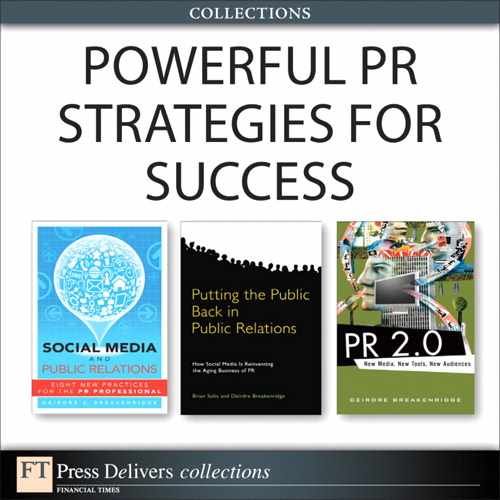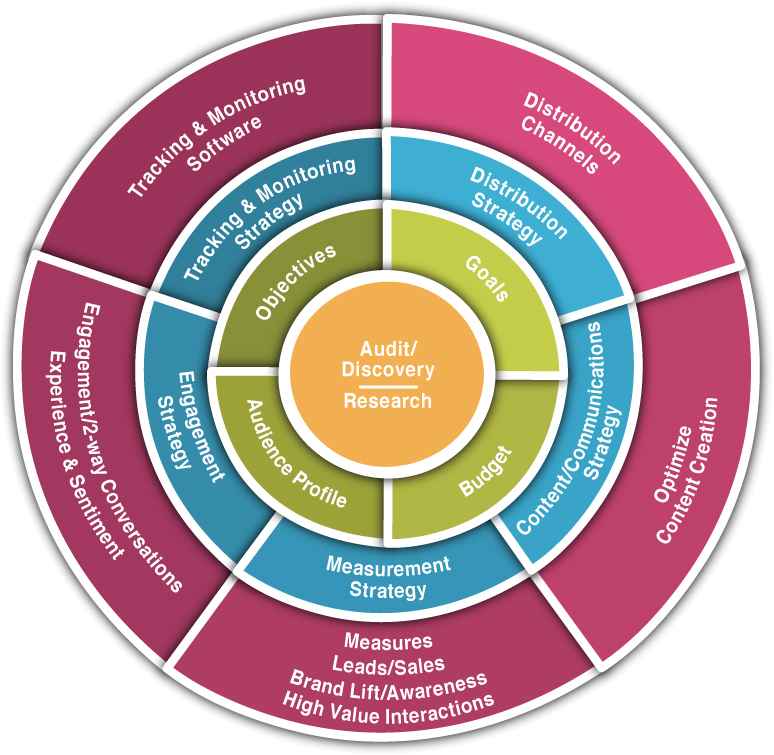Introduction: When Social Media Meets PR, Communication Unites with Technology
Public relations will continue to transform, and the changes you see are monumental. For better or for worse, a career in PR means handling communications in the public spotlight because of the increasing use of social media. In the wake of democratized content and businesses satisfying the needs of the digitally connected consumer, PR had to evolve with a new approach. This approach required a shift in thinking, from strategy and planning all the way through to implementation and measurement. Professionals must discover new research methods, develop specific policies to guide employee and public participation, experiment with content through a variety of social media channels, and learn to connect and build relationships with stakeholders through new technologies.
Every career requires competencies to succeed. In PR, you rely on core competencies, including the ability to research and plan, apply strategies to business goals and objectives, handle issues and crises communications, uphold professional and ethical behavior, manage organizational resources, and demonstrate excellent communications skills. In an age of new media and public conversations, your requirements expand.
In 2011, a pilot study conducted by Sergei Samoilenko of George Mason University, Deborah Ballard-Reisch of Wichita State University, and Bagila Ahatova of Kazakh University of International Relations and World Languages, focused on how “Modern organizations must depend on a new type of communication specialist to creatively solve problems and adapt to rapid organizational change, a global marketplace, and constantly emerging online communities.” The researchers designed a communication competency instrument using a framework developed by Pamela Shockeley-Zalaback (2009). The model consists of four major components: knowledge, sensitivity, skills, and values.
The research project, conducted in Kazakhstan, the ninth-largest country in the world by land area,1 was distributed to professionals holding upper-management positions in public relations. A multi-method survey probed the respondents’ expectations about “crucial communication competencies that university graduates with a degree in public relations should possess in order to be successful in their organizations.” Among the many interesting findings from the study included how the surveyed employers “identified competence in using new information technologies, relationship building, self-control, ability to initiate dialogue...” as the most important skills for young professionals. Whether it’s young professionals entering the workforce or seasoned practitioners, the competent use of information technologies is a necessary skill, which has become a part of the PR professional’s daily practice.2
Social media requires you to shift your mindset to unite communications and collaborative technology. When you adopt a new attitude and expand your knowledge and skills, the result leads to successfully incorporating new practices into your daily responsibilities, personally and professionally. Despite the question, “Who owns social media in an organization?,” PR and communications professionals are in an excellent position to strategically guide all types of communications for their companies, including social media. It’s time to seize the opportunity to learn and embrace communications and technology, from the inside out.
Each new practice introduced in Social Media and Public Relations is the result of what happens when social media meets PR and communications unites with technology. Following are the eight new practices vital to your role today.
PR Practice #1: The PR Policymaker
The PR Policymaker is a professional who quickly learns that a crucial part of the communications strategy and planning process includes the development of social media policies, training, and governance. Not only developing social media policies, but also maintaining them falls within this new PR practice.
PR Practice #2: The Internal Collaboration Generator
The Internal Collaboration Generator is the communications professional who appreciates how social media collaboration starts on the inside of the organization. Because social media moves across the company, it’s imperative you work with specific departments (PR, Advertising, Marketing, HR, IT, Legal, Sales, and so on). You are breaking down the silos to increase sharing, collaboration, and innovation for better internal and external communication.
PR Practice #3: The PR Technology Tester
The PR Technology Tester uses technology strategically for greater peer-to-peer communications. At the start of social media, PR was criticized for not being up to speed on the knowledge and use of social media channels, tools, and technology resources. As a PR Technology Tester, you are not only knowledgeable, but also testing the latest technology for better interactions with the public. The effective use of information technologies is a new core competency.
PR Practice #4: The Communications (COMMS) Organizer
The COMMS Organizer is the PR professional who must educate and redirect an organization to implement a new communications process. No longer can companies solely rely on the push or broadcast method to distribute their messages. Now, it’s your responsibility to make sure your company’s stakeholders are pulling information from the organization. You create new types of stories by developing, coordinating, and curating content through different channels.
PR Practice #5: The Pre-Crisis Doctor
The Pre-Crisis Doctor is the PR professional who realizes every company today can face a crisis. As a Pre-Crisis Doctor, you proactively build crises prevention plans with comment response charts and helpful tools to identify and illustrate levels of crises escalation through all media, including new media. Your new practice requires you to catch the negative sentiment and ease a potentially explosive situation before it escalates to crises proportions.
PR Practice #6: The Relationship Analyzer
The Relationship Analyzer is the PR professional who turns into the communications sociologist with the help of technology. You must observe and analyze how audiences connect—not only with their favorite brands, but also with their peers in web communities. Your new skills include visualizing and mapping the connections for better strategic engagement and higher-level interactions.
PR Practice #7: The Reputation Task Force Member
The Reputation Task Force Member is the PR professional who practices reputation management on steroids. Because social media can change a company’s reputation drastically in a short amount of time, PR professionals must teach about core values and brand voice. They must turn on their tracking/monitoring to high speed to respond with immediacy, constant accuracy, and transparency.
PR Practice #8: The Master of the Metrics
The Master of the Metrics is the PR professional who moves from just accepting metrics (no more Advertising Value Equivalents) to forging ahead with measurable objectives and metrics tied to higher-level organizational goals. In this practice, you learn to differentiate between social media business outcomes versus the outtakes and outputs. Measurement has always been a challenging area, and your level of accountability is even higher with respect to social media communications.
After you read Social Media and Public Relations: Eight New Practices for the PR Professional, you can fully understand what happens when social media meets PR. The union of communications and technology offers PR professionals the potential to mold their performance in a more strategic direction. You can also crystallize how PR has expanded and the tremendous opportunity that awaits you. With new social media practices surfacing, your development and application of strategic activities versus many of the tactical functions in the past raises the value of PR—not only in the eyes of organizational executives, but also how it appears in the eyes of the public.
Your eight new practices can become a part of your social media strategy and planning, which includes the research and discovery process, goal and objective setting, budgeting, monitoring/tracking, channel distribution, communications messaging and content optimization, levels of engagement, and benchmark measurements. Figure I.1 shows the Social Media Strategy Wheel. (For more information regarding the Social Media Strategy Wheel, with details about its components, visit the Appendix.)
Figure I.1. The Social Media Strategy Wheel
Applying these eight practices successfully as they apply to your social media strategy and planning within your organization is a chance to claim your seat at the strategy table. And based upon the nature of the new practices, you can connect to the solutions that keep executives up at night. For this reason, you need to be at the strategy table. Of course, before you dive into learning more about the eight new practices, you must realize mastering public relations today does not mean abandoning core PR principles. No matter what new practices you incorporate into your role, and your company’s communications programs, you must always rely on your strong sense of ethics, critical thinking, keen negotiating skills, unique ability to liaise and build relationships, passion for information and research, and your love of written and verbal communication. These are the tenets of PR, naturally embedded in what you do, especially when you move forward with a new practice.
To fully apply the eight new practices, you must start with a different frame of reference. Be prepared to move PR out of its silo and to learn how to (1) incorporate new knowledge and skills into your work; (2) expand your knowledge of other marketing and digital practices, as you become a hybrid or integrated new media professional; (3) act as a liaison to create unique bonds between different groups that don’t normally work together within the organization, all functioning harmoniously for better internal as well as external communications; and (4) become a PR champion/influencer who educates others and spearhead a change movement.
The new PR mindset takes into consideration how PR extends beyond what you were used to in the traditional realm, what you’ve started to master in the online PR arena, and what you’ve dabbled with in social media. The new mindset is what you can look forward to as you see more businesses becoming “socialized” to meet the needs of their customers. Social media is moving across the organization, from marketing and sales to IT and product development. The future of PR and communications is how you adapt and learn the new practices and how you help your peers to adapt. Embracing new knowledge and skills means you’re ready to also move forward to shift the mindset of your organization. The PR professional who works to incorporate new practices into the organization must go through several phases of change. The goal is to be a propelling force, leading the charge, and a change agent who makes the new practices systemic in your organization.
The future of PR lies in your hands, in the hands of the PR influencer and change agent. How you embrace a new way to think and apply the necessary knowledge and skills determines the direction of your role in PR. You either become increasingly more important and a valuable asset, or if all remains the same, you unfortunately someday become obsolete. PR has a tremendous opportunity, with an expansion affecting how businesses connect with their constituents for deeper engagement. It’s the difference between PR that simply leads to handling and facilitating messages to the type of PR work that results in powerful information exchange and deeper and more meaningful relationships. It begins with you, the communications professional, and your willingness to accept new practices. Social media and public relations together have moved you to a new plateau. Many exciting changes lie ahead. Learn, embrace, practice, and excel.

